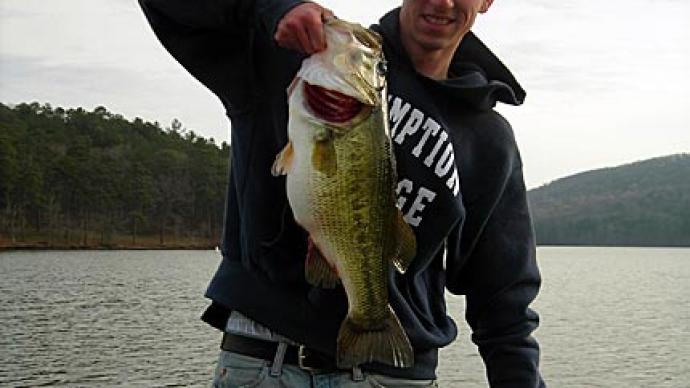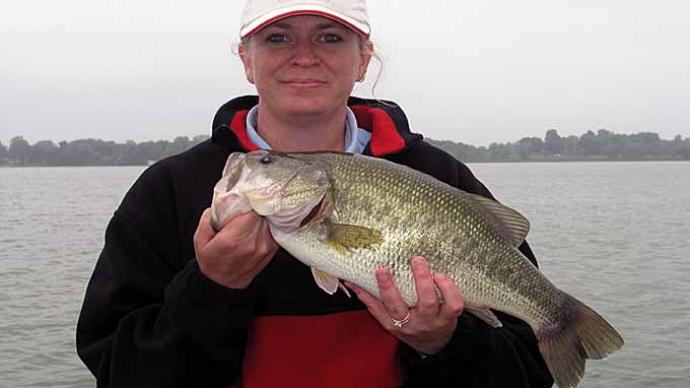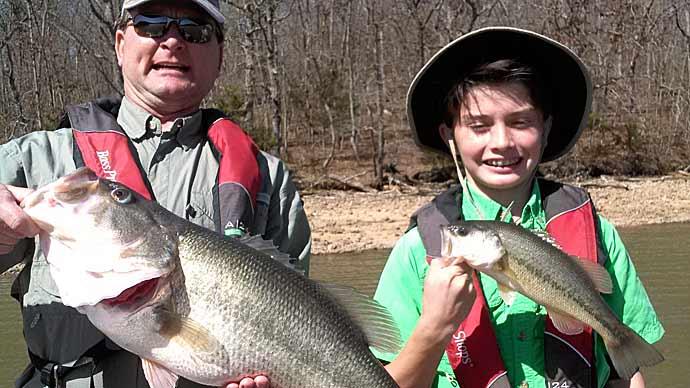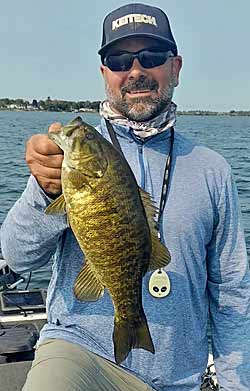
Spring starts with bass having one item on their to-do list — spawn. The drive to check that off is strong, pushing them to migrate to a shallow spot to be warmed by the sun from the protection of a distant wintering hole. But getting from point A to point B isn’t a measured process.
Bass have a regular route, but current conditions determine when they reach their destination. They are cold-blooded, so water temperature dictates their pace, which increases with temperature. And the weather, such as a cold front or a string of several sunny days, can force them to retreat, pause or advance at double time. Spring rain can bring delays, too, whether by raising the water’s level or muddying its color.
While prespawn bass keep an unpredictable pace, the spots they visit while migrating are predictable, year after year and across bodies of water. Once you identify and locate them, catching more bass is a simple process of overlaying current conditions, determining which ones they’re using and their direction.
Define the route
The prespawn migration isn’t for everyone. Major League Fishing Tackle Warehouse Pro Circuit angler Alex Davis said about 30% of bass on any given body of water swim in shallow water year-round. The rest migrate, and you’ll catch more bass by concentrating on this larger group. “The biggest thing is finding them,” he said.
First, define where bass winter and where they spawn. These spots are different on different waters. For example, a wintering hole in rivers may be a deep backwater or the slowest pool. And on a reservoir, it could be a bluff wall on the main lake or the deep-water intersection of a creek channel and river channel.
Spawning sites, first and foremost, need to be shallow enough that the sun can warm eggs, which are usually deposited on a firm surface such as sand, gravel, or even a log. In muddy water, that could be 1 foot deep. And in clear water, it could be 10 feet or more. While bass can spawn anywhere the conditions are favorable, those on lakes and reservoirs usually start in the northwest corner, which receives the most sun in early spring and is protected from brisk northern winds.
Bass don’t take a haphazard approach to migrating between wintering and spawning spots. For example, their route might be as simple in a river backwater as where a depression narrows into a shallow flat. In reservoirs, they’ll follow structure, such as a creek channel or ledge, or cover such as a submerged timber line or what’s left of last summer’s aquatic vegetation into shallow water.
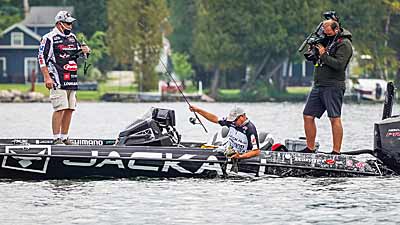
Bass in natural lakes take different routes, something guide Mike Cusano has learned since helping his home state establish an early catch-and-release season as an officer with New York B.A.S.S. Federation. Previously, anglers waited until the third Saturday in June — which continues as opening day for traditional tournaments and catch-and-keep fishing — when most Empire State bass were done spawning. He searches out long points, bottom transitions, such as where muck meets rock, or a depth change near a flat, maybe from 10 to 13 feet up to 4 or 5 feet.
While the length of these “highways” can vary — short on highland reservoirs, for example, and long on low-land reservoirs — they are used yearly.
Find the stops
Whether it’s a creek channel, long point, or subtle depth change, these highways only have to be substantial enough to point bass in the right direction and keep them moving toward their destination. There are specific spots along them where bass will pull over. And stopped bass are the easiest to find and catch.
Bass can be at these specific spots for several reasons. They simply may be passing through. They might be hunkering down, waiting for conditions to stabilize or improve. And they could be feeding.
Stopping spots have one thing in common; they are different than their immediate surroundings. “[Bass] want something different,” Davis said. For example, they'll cling to points if it’s the edge of aquatic vegetation. He said they’ll find the one laydown or a patch of rock or gravel if it's a plain clay bank. The pattern holds true in natural lakes and rivers, too.
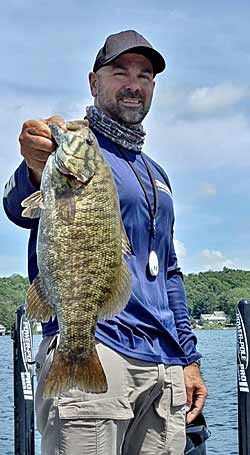
Each prespawn migration route — many on every lake, reservoir, and river — has several stopping spots. While bass use them all, current conditions give you the best directions to the ones they’re using while you’re on the water. Like the children’s game Green Light Red Light, stable or improving conditions give bass the go-ahead, and the longer those remain, the faster and farther bass will travel. A passing front or cold snap has the opposite effect. They cause bass to hunker down on one spot or retreat a spot or more.
Davis provided an example. Migrating prespawn bass will pause where the creek channel they’re following swings against a bank. It’s where erosion can deposit cover into the water and add depth, an inviting combination for bass wanting to wait out a weather change. But if they reach it during a stretch of stable weather, he said they are more likely to swim right past it.
Current conditions also invite bass to make adjustments. Bass may take advantage of clouds and wind, for example, to slide out of a creek channel or ditch to feed on baitfish, which have concentrated on an adjacent flat. Sun and clear water have opposite effects, forcing bass to their route tighter.
Electronics —2-D sonar, side or down scan, forward-facing sonar, 360 imaging — can help find stopping spots early in the prespawn migration. But there will be a point in the advance to the bank when the water becomes too shallow for that technology. Instead, mapping, whether on your graph or in old-fashioned paper form, and your observations become more critical. Topographic charts show you shallow water structure — contours grouped tightly together — that bass can use on their way to protected shallow spots — contours far apart — that are perfect for spawning. Keep an eye out for shallow water stopping spots such as stumps, rocks, or a row of docks.
Stay with them
When prespawn starts and stops depend on your latitude. If you live in the Carolinas, for example, it can run from late January through April. Farther north, it might not start until late March and go into June. Bass don’t all spawn at once. They arrive in waves. And if weather or water conditions hold up one wave, the next one can catch it.
Prespawn bass are known for schooling. With so many trying to funnel into spawning spots, they naturally bunch up on spots. Davis said usually, when and where you catch one prespawn bass, you’re almost guaranteed to catch more in short order. He said some of the heaviest bags he weighed during springtime tournaments consisted of bass caught from the same spot. So, when you get your first bite, work over that spot.
Once the bite slows on the spot and you’ve cycled through a few lures and changed your casting angles, you may be tempted to slow down, switch to a finesse presentation and grind out a few more bass. While that may work, there also is a chance that the school has moved along its migration route. So, consider moving to the next spot, shallower or deeper, depending on how conditions relocate them.
Spawning takes the right spot and a lot of energy. Not only are prespawn bass — especially egg-laden females — at their heaviest weight of the season, they are aggressive eaters, often biting big lures without hesitation. That helps you track them down quicker: Keep moving until you get a bite. There’s rarely a need to convince them to strike.
Fish fast and slow
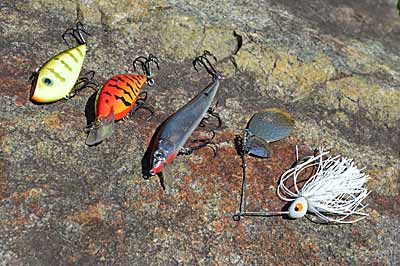
Cusano doesn’t dawdle when searching for prespawn bass. He wants a lure that offers still somewhat sluggish bass an easy meal and allows him to cover water. Jerkbaits are a perfect tool for this fast but slow approach, and he usually picks up a Lucky Craft Pointer in the 78 or 98 sizes. His color choice is linked to water clarity — natural patterns when it's clear and brighter ones when it’s stained.
Davis also prefers lures that keep him moving. But there isn’t one choice to fit all situations. He said crankbaits are great options. You can generate plenty of strikes by crashing diving ones into rock or wood or letting lipless ones settle into aquatic vegetation and ripping them free.
Blades play a role in prespawn, especially later, when more bass are in shallow water. Spinnerbaits, and vibrating jigs provide plenty of action when retrieved slow and still allow you to cover water. And don’t be afraid to bulk up their profile with a big trailer such as a swimbait or 5-inch grub.
Bass starting their migration can be in deep water and out of the effective reach of crankbaits and blade baits. But that doesn’t mean you can’t catch them. Davis picks up a swimbait in this situation. It can be slowly rolled or pulled and paused at whatever depth bass swim.
Jigs catch their fair share of prespawn bass, from deep to shallow, especially if the water temperature is still cool. They, along with a 4- or 5-inch soft-plastic grub rigged on a simple ball-shaped jig head, can be used to cover a variety of depths.


